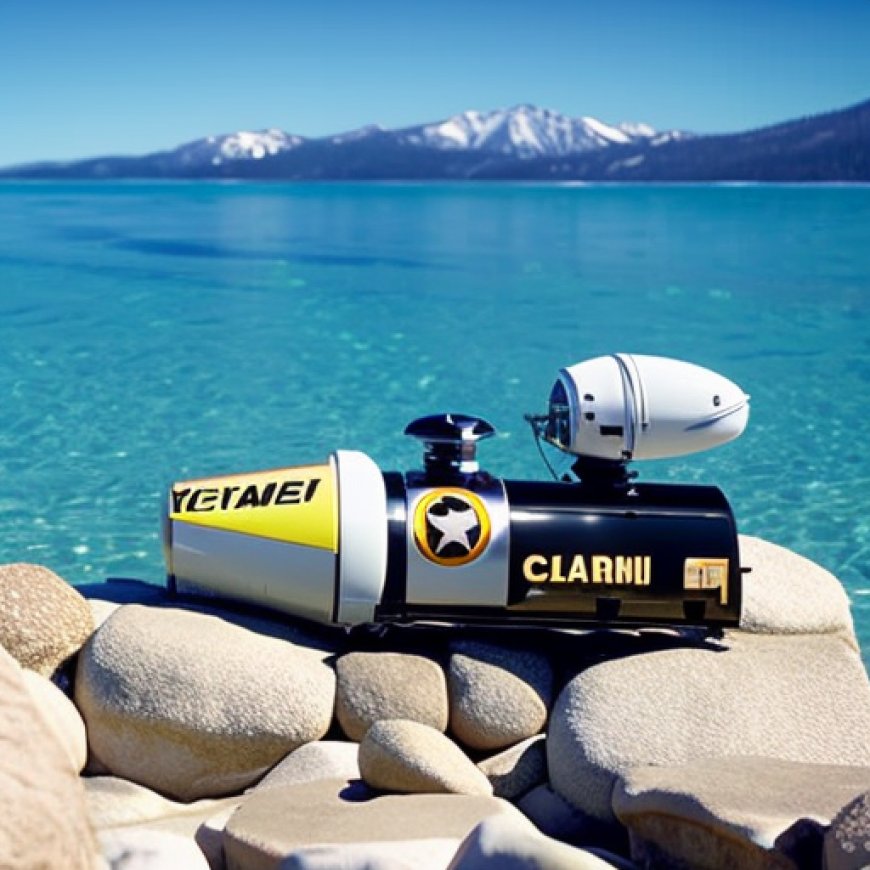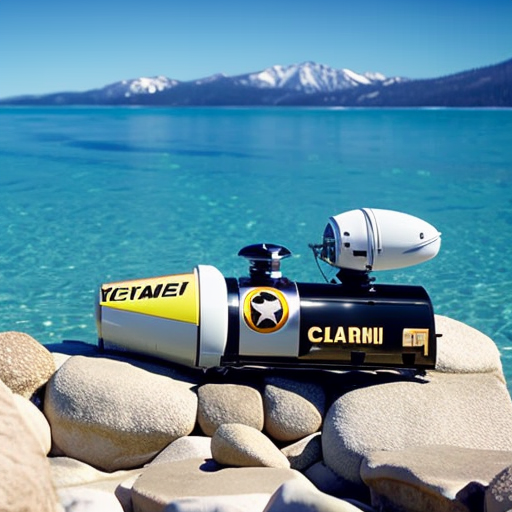New aquatic robot cleans Lake Tahoe’s waters
New aquatic robot cleans Lake Tahoe's waters Sierra Sun


Lake Tahoe Faces Threats to Water Quality and Clarity
LAKE TAHOE, Nev./Calif.– At first glance, Lake Tahoe is pristine. But look closer. Aquatic invasive plants and trash threaten the unique water quality and clarity for which Tahoe is known. Floating debris like plastic litter can leach chemicals into the aquatic environment, while each individual fragment of an invasive weed represents a new potential infestation and further harm to the Lake’s fragile ecology. To Keep Tahoe Blue, the League to Save Lake Tahoe teamed up with ECO-CLEAN Solutions and the Tahoe Keys Marina to introduce an aquatic robot that glides across the surface, removing water-borne debris and aquatic weeds. Meet the PixieDrone.
Combining Technology and Environmental Stewardship
“Together, we’re embarking on a mission to safeguard the pristine beauty of Lake Tahoe, combining cutting-edge technology with environmental stewardship,” said JT Chevallier, co-founder and chief strategy officer of ECO-CLEAN Solutions.
The PixieDrone: A Revolutionary Solution
The PixieDrone is an electric, autonomous and programmable, motorized skimmer. As it moves through the water, the robot captures debris inside its open “mouth,” just like manta rays and humpback whales capture prey. Thanks to on-board Lidar technology (light detection and ranging), the PixieDrone avoids obstacles and adjusts its course in real time, allowing it to navigate between docks, pilings and boat slips as it cleans along a pre-mapped route.
Protecting Lake Tahoe’s Water Quality
“Traditional ways of protecting water quality in the marina simply weren’t enough,” noted Katie Linton, general manager of the Tahoe Keys Marina, the largest marina at Tahoe. “The PixieDrone is an innovative approach to solving a fundamental challenge – safeguarding our beautiful Lake. When the League and ECO-CLEAN brought this idea to us, we jumped at the opportunity to be part of the solution.”

The Tahoe Keys Marina is almost entirely infested with aquatic invasive plants. As boats leave the marina, plants are carried into the Lake, threatening to start new infestations when they settle to the bottom and resprout. The PixieDrone will corral, collect and remove the harmful weeds, so they can’t spread. It can also clean up gas spills and be fitted with scientific equipment to assess water quality. The PixieDrone is currently being tested in the Tahoe Keys Marina where data is being collected and operations perfected for potential future use in other parts of Tahoe.
Addressing Environmental Impacts with Innovative Technology
While Tahoe’s attraction as a travel destination increases, so too does the stress on its ecosystem. Traditional methods for tackling litter on the land and in the water are no longer sufficient. The PixieDrone is the first technology of its kind to be used on the West Coast. Like its robotic, beach-cleaning cousin BEBOT, the PixieDrone represents a novel approach to mitigating environmental impacts. The project partners know that these new tools, if they prove effective, will bolster time-tested techniques and elevate the standard for environmental protection at home in the Sierra and abroad.
“Conservationists and natural resource managers around the world see Tahoe as the blueprint for how to maintain public access while protecting the environment,” said Jesse Patterson, chief strategy officer for the League to Save Lake Tahoe. “For more than six decades, the League has used science, innovation and pilot projects to Keep Tahoe Blue. By sticking to that commitment to evolve, we will overcome new challenges and continue to make Tahoe an example for others to follow.”
Learn more about the PixieDrone at keeptahoeblue.org/pixie.
SDGs, Targets, and Indicators Analysis
1. Which SDGs are addressed or connected to the issues highlighted in the article?
- SDG 6: Clean Water and Sanitation
- SDG 14: Life Below Water
- SDG 15: Life on Land
The article discusses the threats to Lake Tahoe’s water quality and ecology, highlighting the need for innovative solutions to protect the environment. This aligns with SDG 6, which focuses on ensuring clean water and sanitation for all. Additionally, the presence of aquatic invasive plants and floating debris in the lake connects to SDG 14, which aims to conserve and sustainably use the oceans, seas, and marine resources. The article also mentions the potential for the PixieDrone to be fitted with scientific equipment to assess water quality, linking to SDG 15, which focuses on protecting, restoring, and promoting sustainable use of terrestrial ecosystems.
2. What specific targets under those SDGs can be identified based on the article’s content?
- SDG 6.3: Improve water quality by reducing pollution, eliminating dumping, and minimizing release of hazardous chemicals and materials.
- SDG 14.1: Prevent and significantly reduce marine pollution of all kinds.
- SDG 15.8: Prevent the introduction and significantly reduce the impact of invasive alien species on land and water ecosystems.
The article emphasizes the need to protect Lake Tahoe’s water quality from pollution and hazardous materials, aligning with SDG 6.3. It also mentions the threat of aquatic invasive plants and the potential for the PixieDrone to remove them, addressing SDG 15.8. Additionally, the article highlights the PixieDrone’s role in removing floating debris, which contributes to marine pollution and supports SDG 14.1.
3. Are there any indicators mentioned or implied in the article that can be used to measure progress towards the identified targets?
- Indicator 6.3.2: Proportion of bodies of water with good ambient water quality.
- Indicator 14.1.1: Index of coastal eutrophication and floating plastic debris density.
- No specific indicator mentioned for SDG 15.8.
The article does not explicitly mention indicators for SDG 15.8, but the removal of aquatic invasive plants by the PixieDrone can be considered a measure of progress towards reducing their impact on water ecosystems. For SDG 6.3, the article implies the need to monitor the ambient water quality of Lake Tahoe to assess the effectiveness of pollution reduction efforts. The removal of floating debris by the PixieDrone contributes to addressing SDG 14.1, which focuses on reducing marine pollution.
Table: SDGs, Targets, and Indicators
| SDGs | Targets | Indicators |
|---|---|---|
| SDG 6: Clean Water and Sanitation | 6.3: Improve water quality by reducing pollution, eliminating dumping, and minimizing release of hazardous chemicals and materials. | 6.3.2: Proportion of bodies of water with good ambient water quality. |
| SDG 14: Life Below Water | 14.1: Prevent and significantly reduce marine pollution of all kinds. | 14.1.1: Index of coastal eutrophication and floating plastic debris density. |
| SDG 15: Life on Land | 15.8: Prevent the introduction and significantly reduce the impact of invasive alien species on land and water ecosystems. | No specific indicator mentioned. |
Behold! This splendid article springs forth from the wellspring of knowledge, shaped by a wondrous proprietary AI technology that delved into a vast ocean of data, illuminating the path towards the Sustainable Development Goals. Remember that all rights are reserved by SDG Investors LLC, empowering us to champion progress together.
Source: sierrasun.com

Join us, as fellow seekers of change, on a transformative journey at https://sdgtalks.ai/welcome, where you can become a member and actively contribute to shaping a brighter future.







